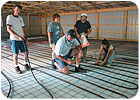
It becomes a little more difficult when the end users can't communicate their needs. Such was the case with the animal inhabitants of a new 2,100-plus-square-foot building that was recently constructed at Rehabitat, a nonprofit organization dedicated to the rehabilitation of injured and orphaned birds of prey (as well as other critters).
Wendy Looker, the director of the facility, heard that radiant heat could offer the greatest comfort for her feathered and furry charges while saving operation costs; however, she was concerned that the first cost might be too high. Rehabitat relies mainly on donations and volunteers, so a tight budget was in place for the new building and its heating system.
Fortunately, Looker found a friend in David Yates, president, F.W. Behler Inc., York, Pa., a 106-year-old plumbing and mechanical firm that specializes in radiant heating systems. Yates knew that Rehabitat was a special place, so he worked with a group of volunteers in order to make sure the recuperating animals would have a warm place before winter.
VOLUNTEER FORCE CUTS COSTS
Yates sat down with Looker and listened carefully to her requirements before coming up with the final design for the radiant heating system. The new facility needed to be divided into three distinct zones, with each having different environmental conditions. One zone would be for wild dogs (dingoes), bearcats, and other four-legged creatures; a center zone would be for macropods (kangaroos, wallabies, and a tree sloth); and the third zone would be for raptors.While energy efficiency was a concern, it was secondary to keeping the recovering animals comfortable. Equipment reliability was of paramount importance not just to Looker, but to Yates as well, who said, "We're the ones who must respond in the middle of the night if things don't work. That's important to our customers, too, but much more critical in a hospital-like environment where loss of conditioned comfort might well cause death."
As already mentioned, first cost was a major issue, due to Rehabitat's limited budget, but Yates had an answer for that as well: Recruit volunteers to supply the labor. First on that list was Yates's son, Mike, who was working towards Eagle rank in the Boy Scouts and needed service hours. As a result, the majority of the approximately $12,000 cost for the heating system was for materials alone.
This all-volunteer force was initially a concern for Yates, particularly because he didn't meet any of them until installation began. "Those concerns quickly faded the first night, though, as the volunteers were quick to learn and hard workers," said Yates. Prior planning and precise designs eliminated the potential for problems, as any wrinkles were ironed out on the drawing board before the plans left Yates' office.

WALLABIES WELCOME WARMTH
The volunteer work force had no previous experience with installing a radiant heating system, and the work would take place at night under artificial lighting. For these reasons, Yates decided to specify easy-to-install Onix radiant tubing made of synthetic rubber. The Watts Radiant product was easily positioned and secured to the wire mesh reinforcement. Yates noted that one of the benefits of using the Onix tubing is it stays where it's laid, without springing back like a PEX product, so there's less potential for personal injury.A compact, wall-mounted, direct-vent, propane-fired Mini-Therm boiler by Laars Heating Systems, and a pre-manufactured HydroControl injection panel made by Watts Radiant were installed - far away from the little creatures who might be tempted to gnaw on them. Injection pumping was utilized so that small diameter PEX tubing could be run to the remote manifolds located in each of the three zones where the Onix tubing loops were gathered and connected.

Another benefit to using injection pumping is that it incorporates variable speed, which enhances comfort and reduces energy consumption. Injection manifolds were kept close to the floor and boxed in to keep both critters and radiant products safe from harm.
Ventilation was accomplished via manually controlled roof fans and pet-type doorways that allow the animals to freely move outside. These doorways aren't exactly air-tight, said Yates, so they serve as a source of outdoor air for all but the raptor section.

As an animal lover and one who likes a good cause, Yates truly enjoyed designing and installing the radiant heating system at Rehabitat. The only thing he might change if he were to do it again would be to schedule the work when it was less humid and much cooler. The installation took place in August, during what turned out to be some of the hottest weeks of the year. But Yates was able to meet - and pet - a kangaroo, which made it all worthwhile.
He received an even bigger thrill when, toward the end of the installation, a newborn wallaby entered the wildlife Rehabitat family and was named Davey - for the staff's favorite radiant heating contractor.
Publication date: 08/28/2006


Report Abusive Comment